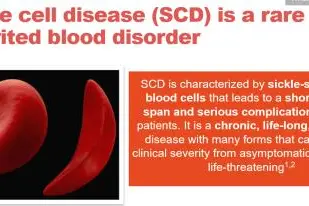PHOTO
- Sickle cell pain crises or VOCs are considered the clinical hallmark of the disease, and are triggered, in part, by multicellular interactions that form clusters of cells, which can block or reduce the blood flow to organs.2 Sickle cell pain crises can be frequent and sudden, and are associated with an increased risk of life-threatening complications.13,14
- A reduction in VOCs is therefore the focus of scientific innovation in this disease area, and a key measure of its success.
- Sharing inspirational stories of Sickle Cell patients from around the world lends a positive light to those affected by the disease and reaffirms that these patients overcome many hurdles to be productive in the society.
- June 19th has been designated as World Sickle Cell Day and in 2020 will run under the campaign NOTALONEINSICKLECELL, (notaloneinsickcell.com), and rethinksicklecelldisease.com
Dubai – Sickle cell blood disease is known to be one of the most common and painful genetic blood disorders in the world1. Its impact is debilitating to those who suffer from it as well as for families and communities that surround the patients. Raising awareness on the disorder helps those affected with knowledge on coping with the disease, making them part of a large global community and support system. Every June 19th, sickle cell patients, their loved ones, medical staff, and patient organizations dedicate the day to bringing attention to the disease, distributing knowledge, and empowering those affected. This year the day will be coined by the phrases “Know More, Do More Together” and “NotAloneInSickleCell”, highlighting the importance of knowledge and information in learning to live and cope with the disorder and sharing inspirational stories of how patients from around the world overcome challenges and motivate themselves in difficult times. Through the platform www.notaloneinsicklecell.com users have access to these motivational stories from all over the world.
Sickle cell disease is a complex and debilitating genetic blood disorder that goes beyond sickle-shaped red blood cells. The disease is associated with chronic inflammation, causing higher levels of cell adhesion proteins, including P-selectin, which make both the blood vessels and certain blood cells stickier and prone to multicellular interactions, or clusters, in the bloodstream3, 4, 5. This environment can lead to the acute episodes of pain known as sickle cell pain crises, or VOCs, as well as life-threatening complications.2 VOCs are the main reason why individuals living with sickle cell disease seek medical care in hospitals, 13, 14 leading to approximately 200,000 ER visits in the US every year.
As described by Doctor Thuraya AL Hosni head of Oman Patient Organization: “Pain of sickle cell crisis is indescribable, it is like having a hammer and knocking on your bones the hardest you can with increasing and repeated frequencies as well. It is a very terrible pain. For a lady this pain is only 20% of what a labor pain feels.”
To mark World Sickle Cell Day on June 19th, 2020, Novartis Oncology Gulf in collaboration with patient organizations and medical communities, will conduct a series of activities such as interviews with doctors and specialists as well as media round-table conversations across the UAE, Oman, Bahrain and Kuwait. These initiatives will be frequently repeated until the end of the year, in hopes of maintaining momentum in the race to spread information and awareness on the disorder and to urge patients seek the medical attention and mental support available to them. In a statement by a Novartis spokesperson Wael Omran, Oncology General Manager-Region Gulf: “In our quest to find new medicines, we consistently rank among the world’s top companies investing in research and development. Our partnership with the health authorities across Gulf Countries aims to improve the diagnosis and treatment of people with sickle cell disease through a comprehensive approach that includes treatment and disease management, training and education, and elevating basic and clinical research and scientific capabilities.”
Sickle cell disease affects millions globally, with symptoms that vary in clinical severity depending on each individual case2; these patients have long suffered silently through unimaginable pain crises. However, with research come new treatments which will help thousands of people living with sickle cell by reducing the frequency of their pain crises and potential life threats. This brings a new string of hope to the sickle cell disease community for a brighter future with more VOC-free days.
Patients with sickle cell disease experience a shortened lifespan, living only into their 40s7. This is why early diagnosis, ongoing patient education and awareness, and simple medical care, including access to blood transfusions and hospital treatment, can greatly improve patients’ life expectancy4. However, in many regions of the world, these measures are not available, and management remains inadequate4. Life expectancy is still reduced by about 20-30 years even in a high-income settings. Wael Omran concluded, “As a leading global medicines company, Novartis is reimagining medicine to improve and extend people’s lives, that includes taking steps to help address the needs of patients with sickle cell disease, we use innovative science and digital technologies to create transformative treatments in areas of great medical need such as sickle cell disease.”
www.rethinksicklecelldisease.com
www.notaloneinsicklecell.com
About Novartis
Novartis is reimagining medicine to improve and extend people’s lives. As a leading global medicines company, we use innovative science and digital technologies to create transformative treatments in areas of great medical need. In our quest to find new medicines, we consistently rank among the world’s top companies investing in research and development. Novartis products reach more than 750 million people globally and we are finding innovative ways to expand access to our latest treatments. About 109,000 people of more than 140 nationalities work at Novartis around the world. Find out more at
Novartis is on Twitter. Sign up to follow @Novartis at http://twitter.com/novartisnews and follow @NovartisCancer at https://twitter.com/NovartisCancer
For Novartis multimedia content, please visit www.novartis.com/news/media-library
For questions about the site or required registration, please contact media.relations@novartis.com
References
- Jain D, Lothe A, C Roshan. Sickle cell disease: current challenges. Journal of Hematology & Thromboembolic Diseases. 2015 Nov 10. Doi: 10.4172/2329-8790.1000224.
- Steinberg M. Management of sickle cell disease. N Engl J Med. 1999;340(13):1021-1030.
- Gallo A, Wilkie D, Suarez M, et al. Reproductive decisions in people with sickle cell disease or sickle cell trait. NIH Public Access. 2010;32(8):1073-1090.
- Piel F, Steinberg M, Rees D. Sickle cell disease. N Engl J Med. 2017;376(16):1565.
- Yawn B, Buchanan G, Afenyi-Annan A, et. Management of sickle cell disease summary of the 2014 evidence-based report by expert panel members. JAMA. 2014;312(10):1033-1048.
- Gutsaeva D, Parkerson J, Yerigenahally S, et. Inhibition of cell adhesion by anti–P-selectin aptamer: a new potential therapeutic agent for sickle cell disease. Blood. 2011;117(2):727-735.
- Adegbola M, Barnes D, Opollo J, et. Voices of adults living with sickle cell disease pain. J Natl Black Nurses Assoc. 2012;23(2):16-23.
- What is sickle cell disease?. Last updated: August 2, 2016. Available from: http://www.nhlbi.nih.gov/health/health-topics/topics/sca.
- Key NS, Derebail VK. Sickle-cell trait: novel clinical significance. Hematology. 2010;(1):418-422.
- Mandal A, Leger R, Graham L, et al. An overview of human genetic disorders with special reference to African Americans. J Bioprocess Biotech. 2015 October 27. doi:10.4172/2155-9821.1000e139.
- American Society of Hematology. State of sickle cell disease 2016 report. Available from: http://www.scdcoalition.org/pdfs/ASH%20State%20of%20Sickle%20Cell%20Disease%202016%20Report.pdf. Accessed on March 21, 2019.
- Dennis-Antwi JA, Dyson S, Ohene-Frempong K. Healthcare provision for sickle cell disease in Ghana: challenges for the African context. Diversity in Health and Social Care. 2008;5:241–54.
- Puri L, Nottage K, Hankins J et al. State of the art management of acute vaso-occlusive pain in sickle cell disease. Paediatr Drugs.2018 Feb;20(1):29-42.
- Ballas S, Gupta K, Adams-Graves P. Sickle cell pain: a critical reappraisal. 2012;120:3647-3656.
- Anim M, Osafo J, Yirdong F. Prevalence of psychological symptoms among adults with sickle cell disease in Korie-Bu Teaching Hospital, Ghana. BMC Psychology. 2016;4(53):1-9.
- Osunkwo I, Andemariam B, Inusa B, et al. Management Strategies and Satisfaction Levels in Patients With Sickle Cell Disease: Interim Results From the International Sickle Cell World Assessment Survey (SWAY). Poster presented at: The American Society of Hematology Annual Meeting; December 7-10, 2019; Orlando, FL.
- Alkindi S, Al Zadjali S, Al Madhani A, Daar S, Al Haddabi H, Al Abri Q, et al. Forecasting hemoglobinopathy burden through neonatal screening in Omani neonates. Hemoglobin.2010 Jan; 34(2):135-44. Al-Arrayed S, Hafadh N, Amin S, Al-Mukhareq H, Sanad H. Student screening for inherited blood disorders in Bahrain. East Mediterr Health J 2003; 9: 344-52. Adekunle D. Adekile, Sondus Al-Sherida, Rajaa Marouf, Nada Mustafa & Diana Thomas (2019) The Sub-Phenotypes of Sickle Cell Disease in Kuwait, Hemoglobin, 43:2, 83-87.Al Hosani H, Salah M, Osman HM, Farag HM, Anvery SM. Incidence of haemoglobinopathies detected through neonatal screening in the United Arab Emirates. East Mediterr Health J 2005; 11 :
300-7. Hamad Medical Corporation 2017 report.
Novartis Media Relations
E-mail: media.relations@novartis.com
Joy Khoury
Head Communications and Patient Advocacy
joy.khoury @novartis.com
Diaa Al Jurdi
Communication Manager- Pencell
diaa.dubai@pencellpr.com
Lana Khaddaj
Patient Group Relations & Communications Manager
lana.khaddaj @novartis.com
© Press Release 2020
Disclaimer: The contents of this press release was provided from an external third party provider. This website is not responsible for, and does not control, such external content. This content is provided on an “as is” and “as available” basis and has not been edited in any way. Neither this website nor our affiliates guarantee the accuracy of or endorse the views or opinions expressed in this press release.
The press release is provided for informational purposes only. The content does not provide tax, legal or investment advice or opinion regarding the suitability, value or profitability of any particular security, portfolio or investment strategy. Neither this website nor our affiliates shall be liable for any errors or inaccuracies in the content, or for any actions taken by you in reliance thereon. You expressly agree that your use of the information within this article is at your sole risk.
To the fullest extent permitted by applicable law, this website, its parent company, its subsidiaries, its affiliates and the respective shareholders, directors, officers, employees, agents, advertisers, content providers and licensors will not be liable (jointly or severally) to you for any direct, indirect, consequential, special, incidental, punitive or exemplary damages, including without limitation, lost profits, lost savings and lost revenues, whether in negligence, tort, contract or any other theory of liability, even if the parties have been advised of the possibility or could have foreseen any such damages.











